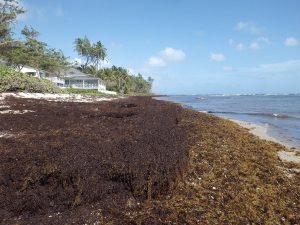So argue Julien Jouanno et al., in An extreme North Atlantic Oscillation event drove the pelagic Sargassum tipping point, published in Nature Communications Earth & Environment published Feb 8, 2025.
Abstract (Bolding inserted)
The proliferation of pelagic Sargassum in the tropical Atlantic since 2011 is causing considerable health and economic concerns as large amounts of this brown alga arrive and accumulate in coastal ecosystems of western Africa and of the greater Caribbean Sea every year.
Many hypotheses have been proposed to explain the recurrence of Sargassum blooms since 2011 and their year-to-year variability. Among the hypotheses being debated about the origin and nutrient source to support the blooms are either: a) an increase in nutrient supply to the Atlantic Ocean via continental, or atmospheric inputs, or b) long-distance transport of a seed population during the North Atlantic Oscillation (NAO) event of 2009/2010 and stimulation of blooms in the tropical North Atlantic by nutrient supply primarily due to seasonal vertical mixing of the upper water column.
The aim of this study is to address these alternate hypotheses. To this end, interannual numerical simulations (2002-2022) representing the transport, growth, and decay of pelagic Sargassum have been developed at basin scale.
Our results confirm the role played by the NAO transport anomaly on the regime shift that occurred in 2010, and the primary role of vertical mixing in the tropical Atlantic as the primary nutrient source for the recurring blooms since 2011.
A popular account of the article by Richard Luscombe was published in The Guardian on March 22, 2025: Scientists identify ‘tipping point’ that caused clumps of toxic Florida seaweed
For more info. about Sargassum blooms, see
-
- Sargassum Information Hub
Information about Sargassum in the Tropical Atlantic.
The Hub provides information about:
• What sargassum is and why it is important
• Monitoring and forecasting of sargassum in the tropical Atlantic
• Management of sargassum
The Hub is jointly organized by the GEO Blue Planet, IOCARIBE of IOC-UNESCO, AtlantOS, and the Atlantic International Research (AIR) Center, in collaboration with several partners [including UWI based CERMES] - CERMES: Sargassum Outlook Bulletin
“Our Sub-regional Sargassum Outlook Bulletin provides medium-range (3-monthly) island-scale forecasts of sargassum influxes to the Eastern Caribbean, based on our validated sargassum transport model from the new source region in the equatorial Atlantic. It also provides comment on sector-specific implications for tourism and fisheries stakeholders, and provides summaries and links to the latest sargassum papers and innovations. By simplifying scientific jargon so that stakeholders can easily understand and benefit from the forecasts, we anticipate that the bulletin will facilitate wider access to specifically tailored early warning information, thus allowing better decision-making by key socio-economic sectors in the Eastern Caribbean islands.”
- Sargassum Information Hub

